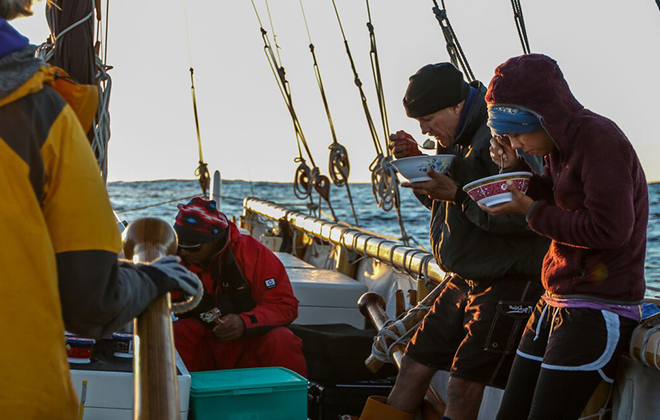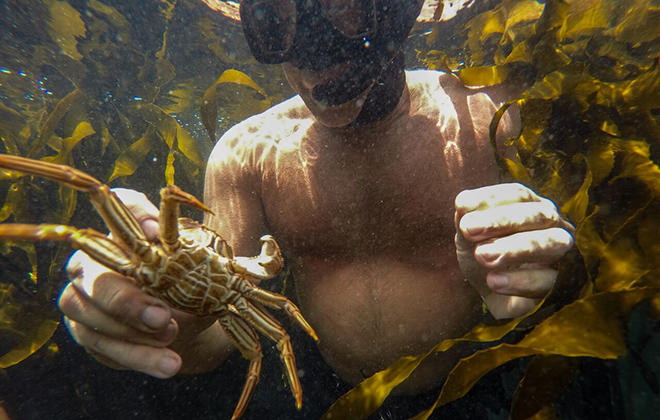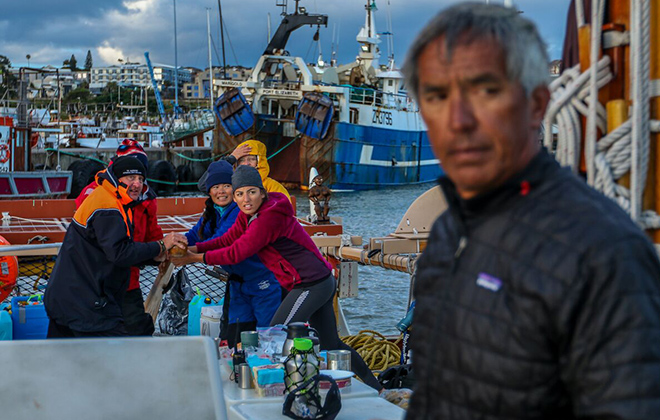Hokule‘a to visit origins of humanity

The Hokule‘a crew, pictured leaving Port Elizabeth, is heading to Cape Town for its final stop on the South African leg of its voyage.

The crew went on a dive through the dense kelp forest in False Bay and on a coastal walk. Part of the bay is a marine reserve. Two years ago the bay was designated as a "Hope Spot" by the Mission Blue initiative, or a place critical to the ocean's health.

The Hokule‘a crew along with master navigator Nainoa Thompson leave Port Elizabeth, South Africa. They are now halfway through their Malama Honua (“Care for the Earth”) worldwide voyage.

The crew made a stop in Simon’s Town, South Africa, to see conservation efforts in False Bay.




Crews of the Hawaiian voyaging canoe Hokule‘a have spent the past year and a half pushing their limits, sailing the vessel as far from home as they ever could.
Now halfway through their Malama Honua (“Care for the Earth”) worldwide voyage and halfway across the planet in South Africa, they aim to learn more about themselves by encountering some of humanity’s earliest origins. They’ll also greet one of this generation’s biggest champions for human rights.
“Being directly on the other side of the world, it’s a compelling image … of one of the youngest cultures connecting with probably the oldest cultures,” said Randie Fong, Kamehameha Schools’ executive culture officer.
The Hawaiian culture is relatively young compared to most other regions, with some estimates putting the islands’ first human settlement around A.D. 400.
Africa, on the other hand, is known to be the birthplace of humankind.
The Polynesian Voyaging Society, which is leading Malama Honua, has been anticipating this moment for years. The group’s president and Hokule‘a captain, Nainoa Thompson, sees it as a unique chance for some of the earth’s youngest people, anthropologically speaking, to pay homage to some of its oldest.
Don't miss out on what's happening!
Stay in touch with breaking news, as it happens, conveniently in your email inbox. It's FREE!
The Honolulu Star-Advertiser will be along for the ride in an ongoing partnership with the Polynesian Voyaging Society, with this reporter serving as both a crew member aboard Hokule‘a on certain legs of the Malama Honua voyage while also documenting the journey independently.
Next week Fong will lead a group of Kamehameha and Halau Ku Mana Public Charter School students to join Hokule‘a crew members at the seaside caves of Mossel Bay, more than 200 miles east of Cape Town. Research indicates that Mossel Bay may be the cradle of world civilization — a place where prehistoric people developed tools and art, and where several hundred of them kept humanity alive during an ancient ice age.
While in Cape Town, the canoe crews and student delegation also plan to greet Archbishop Desmond Tutu. The celebrated South African human rights advocate and Nobel Peace Prize winner served as a moral compass during the nation’s troubled apartheid era, along with leaders such as Nelson Mandela.
In going to Mossel Bay, “We are reaching back into our own Hawaiian senses of the first human,” Fong said. “To celebrate that coast is to … look into our own traditions of human creation, and to have those two meet. We want to connect to the significance of Hawaiians, and our senses and our universe.”
It’s the latest chapter for Hokule‘a in what South African native and University of Hawaii-West Oahu political science professor Louis G. Herman has dubbed a “truth quest” — a primal journey to better understand one’s self and the best way to live.
Since Hokule‘a’s May 2014 departure from Hilo, some 165 crew members, sailing aboard either the canoe or an escort vessel, have participated in an odyssey of more than 18,000 miles across the Pacific and Indian oceans. (That figure includes the sail home for Hokule‘a’s previous escort vessel, the voyaging canoe Hikianalia.)
They’ve been pushed physically and mentally at times to sail through punishing weather upon a 62-foot-long, double-hulled canoe. They’ve had to live and work together “with aloha” in tight quarters while sailing for days at sea.
While not on watch, many of them have spent hours meditating on the vast, surrounding ocean wilderness and contemplating their place in the world.
They’ve also learned what other communities are doing to help conserve natural resources and to stave off the impacts of climate change. They’ve met with world leaders such as United Nations Secretary-General Ban Ki-Moon, who, while aboard Hokule‘a’s deck in Apia, Samoa, last year, pledged to take more steps to protect the oceans.
When the students from Hawaii meet Tutu, they’ll sing “Ho‘oheno Keia No ‘Akipihopa Desmond Mpilo Tutu.” Fong composed the song in Hawaiian to praise the South African icon.
It touts Tutu as a “great navigator of the earth” — a concept that Thompson first suggested, according to Fong. Navigators can refer more broadly to include those who guide their communities, not those just who guide vessels across the sea, Fong explained.
Tutu helped dismantle South Africa’s oppressive segregation-based apartheid system. He’s confronted some of the ugliest human rights violations in our time, notably when he led South Africa’s post-apartheid Truth and Reconciliation Commission.
At Mossel Bay, recent archaeological finds indicate that every person alive today might trace their roots back to several hundred early humans beings.
There, they survived a much earlier crisis involving the planet’s climate — a prolonged ice age that began about 195,000 B.C., lasted tens of thousands of years and caused the human population to plummet, according to Arizona State University archaeology professor Curtis Marean and his 2010 Scientific American article, “When the Sea Saved Humanity.”
Marean said his archaeology team has also unearthed at Mossel Bay powders and decorative shells that he believes to be the earliest forms of “symbolic behavior” on record — the beginning of art.
“We’re talking about the origins of humanity, the origins of our species, the origins of us as human beings,” added archaeologist Peter Nilssen in a 2013 lecture on Pinnacle Point, part of Mossel Bay. It’s where humans survived a “near-extinction event of our species,” he said.
Hokule‘a crews aim to promote environmental conservation and cultural harmony with their worldwide sail. Thompson has described the canoe as “a needle traveling across the earth” collecting examples of communities trying to live more sustainably.
The canoe and its current escort vessel, Gershon II, are now pushing to the south and west against what crew members have described as exhausting, frigid sailing conditions, aiming to arrive in Cape Town later this week.
Once there, Hawaiians and South Africans plan to celebrate with a ceremony that UH’s Herman calls a “powerful symmetry of opposites,” with South Africa being one of the first points of human expansion and Hawaii one of the last places on earth that humans reached.
Hokule‘a’s truth quest — its journey around the globe — is just halfway done. The Polynesian Voyaging Society expects to have the canoe home in 2017.




